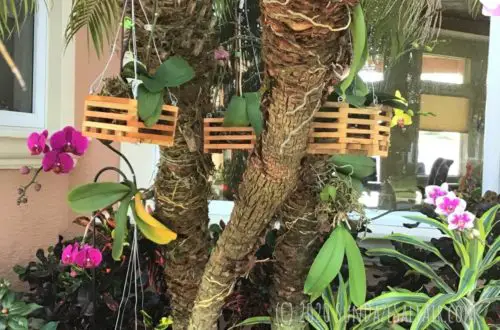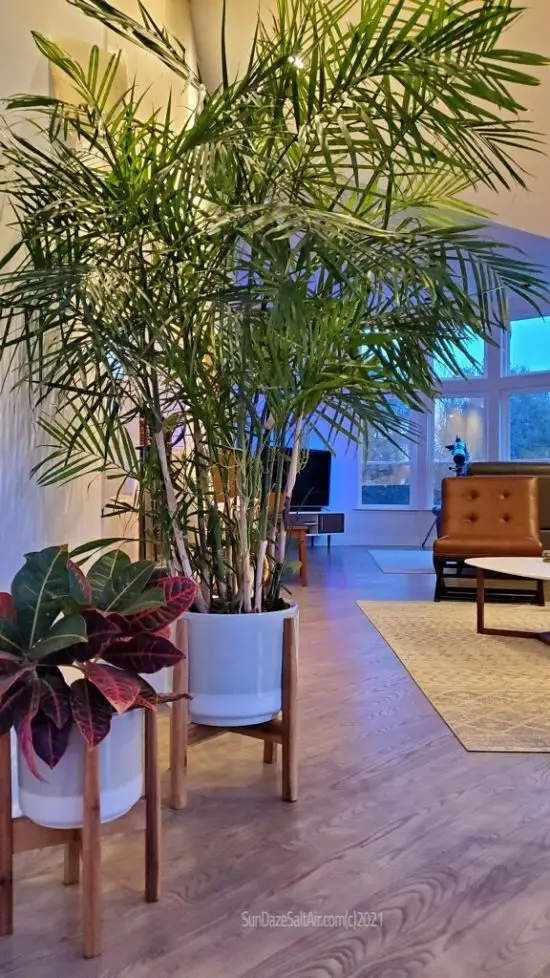
How To Care For An Indoor Majesty Palm & How To Quickly Recognize & Treat Signs Of A Dying Majesty Palm
Why Is My Majesty Palm Dying? Seven Mistakes You Are Making, Signs To Look For & How To Treat Them
Majesty palms can be one of the most challenging plants to grow indoors, but will be rewarding if you master it. The challenge stems from the fact that many of the majesty palm's preferences, including bright light, moist soil, and high humidity, are conditions not typically found, or desired, in the typical home. In this article, I'll discuss how to care for an indoor Majesty palm, seven common mistakes home growers make, and how to quickly recognize and treat signs of a sick or dying Majesty palm. But first, let's discuss a few reasons to make a Majesty palm an addition to your home.
Bring A Touch Of The Tropics Inside Your Home - No Matter Where You Live
Leaf through any home decor catalog or scroll through any social media feed and you will see the graceful green, wispy arching fronds gracing dwelling interiors seemingly everywhere. Of course, I am referring to that regal representative of the tropics known as the Majesty palm, botanical name Ravenea rivularis. While potted Majesty is relatively small in size compared to its outdoor-dwelling cousins, this tropical tree lives up to its name with its regal and elegant looks. With feathery palm fronds reminiscent of palm trees swaying gracefully in the breeze of a Caribbean island paradise, the Majesty palm is a favorite of home decorators and lovers of tropical foliage alike.
Beautiful Air Purifiers? Majesty Palms Help To Purify The Air Inside Your Home
Not only will your Majesty palm add an island vacation ambiance to your home, but your Majesty will also help purify and clean the air you breathe indoors. Through the process of photosynthesis your Majesty palm helps convert the carbon dioxide you exhale into fresh oxygen, while also helping remove some common harmful toxins from your home, which may include formaldehyde, benzene, and carbon monoxide.
How Large Can You Expect A Healthy Indoor Potted Majesty Palm To Grow?
A Majesty palm in its native outdoor habitat grows tall and majestic - often reaching heights upwards of 40 plus feet! Thankfully, the indoor houseplant version of the Majesty palm, majestic sounding name notwithstanding, can be expected to achieve a height of between five and ten feet at maturity with proper care, thanks in part to its slow growing nature, especially when constricted in a pot. The Majesty's thick trunk is a major factor that contributes to slow growth, and while it doesn't always appreciate being constricted, this does help keep the tree relatively small in stature.
However, your Majesty palm can still thrive when grown in containers, even if it won't reach heights larger than a smaller-sized tropical tree. Which, of course, makes the potted Majesty the ideal sized tree for the home grower just looking to add a touch of the tropics to their daily life. What is not ideal, however, is the Majesty's demanding nature which most home growers find difficult to satisfy.
So, how exactly can you keep your Majesty palm alive and well inside your home so far from its tropical rainforest origins?
Read on for all you need to know to keep your Majesty healthy and thriving; seven common mistakes home growers make in caring for Majesty palms; plus, how to quickly recognize and treat a sickly Majesty palm.
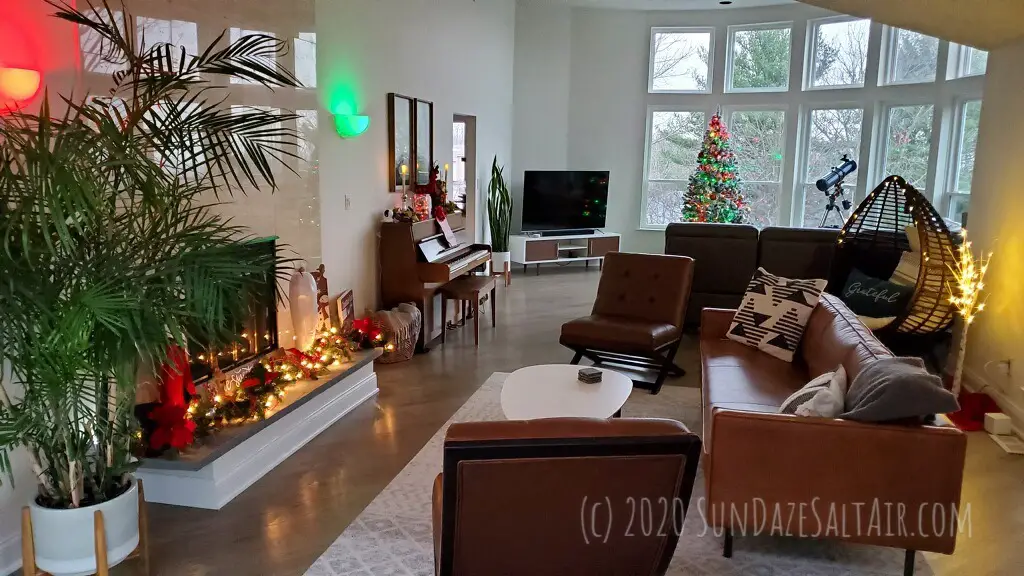
**********
How To Care For An Indoor Majesty Palm - Seven Common Mistakes Home Growers Make Plus How To Recognize Signs Of A Dying Majesty Palm & Easy Solutions
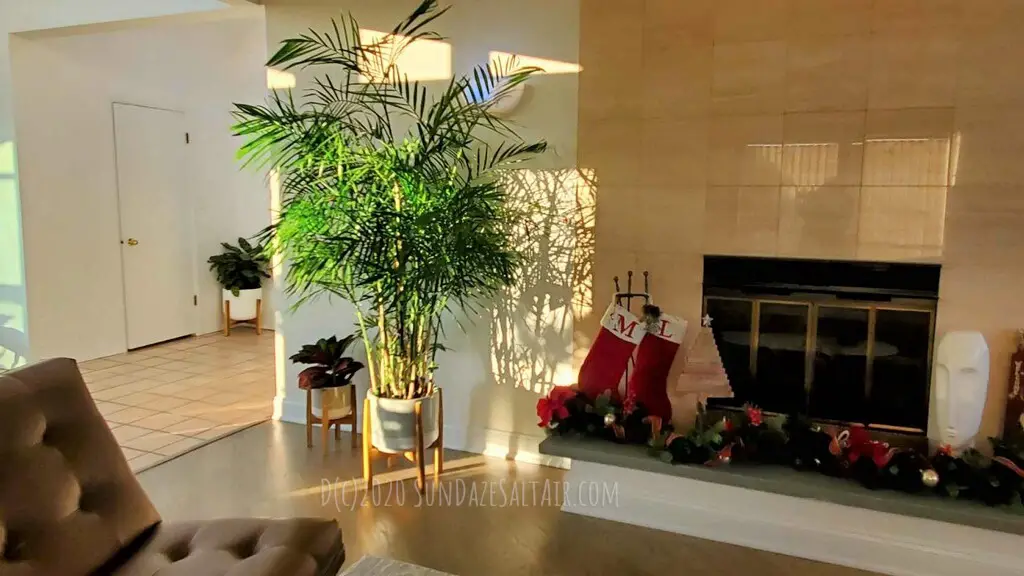
Majesty Palm Mistake # 1: Placing Your Majesty Palm In Locations That Are Too Shady - Your Majesty Palm Likes Lots Of Light But Beware Direct Light When Indoors
Signs your Majesty palm is not getting enough sunlight:
This is a big one, and a major reason many indoor grown Majesty palms fail to thrive. If you notice the lower leaves on your palm are turning yellow, there's a good chance your Majesty palm is not receiving enough light. You'll also notice new, burgeoning growth at the top of the palm struggles to open.
Without sufficient sunlight, your Majesty palm does not have abundant energy to perform photosynthesis, the process which maintains the plant's green pigments. As a result, whatever energy is conserved will go to supporting newer, younger leaves at the top of your palm, allowing older leaves at the bottom to yellow and fall off.
A special challenge that home growers of indoor tropical palms face is not just the Majesty palm's need for bright light, but the type of bright light. For instance, since your indoor majesty does not get as much moisture as it would outdoors, your majesty will not appreciate being left to stand in front of a bright, unfiltered window. Indoor Majesty palms prefer a specific type of sunlight, namely one that is indirect. Native to the rainforests of Madagascar where they are bathed in diffused light under the sun-dappled forest canopy, the Majesty palm also needs a large amount of this indirect sunlight to remain optimally healthy and thriving.
Requiring between six (6) to eight hours (8) of indirect sunlight daily year round makes Majesty palms, not surprisingly, potentially problematic for most home-growers and a cause of struggling, sickly plants. This is of particular concern during the winter given the fact that finding abundant amounts of sunlight in most homes in northern latitudes in the dead of winter is about as likely as finding sunbathers on the beach of Lake Michigan in January.
Solution to insufficient light:
I had a Majesty near a bright window that simply failed to thrive. As close to the window as it was, there were just not enough hours of light in this spot. The last straw was when I saw new growth struggling to open. I knew the Majesty wouldn't make it unless I found a new and better location for it. It turns out I had a newly empty spot in a planter right next to the pool in need of something. I took my now formerly indoor Majesty outside and planted it right in the inground planter by the pool. Sure enough, almost like a miracle, a couple of days later, I saw the characteristic fanning of the two new palm leaves begin to open up.
Since the palm is now outdoors, receiving ample humidity, direct light is no longer a problem like it often is when indoors. The abundant sunlight outside was what this Majesty needed. Sometimes a Majesty palm is just not meant to be in a pot indoors if it doesn't receive enough sun. If you have low light conditions, consider another, more shade-tolerant variety of palm for indoors, such as a Lady Palm, Kentia Palm, Areca Palm, or even a Chinese Fan Palm.
If you still haven't given up, try to provide your indoor Majesty with at least six to eight hours of bright yet indirect light per day, similar to shady rainforests. Be sure to relocate your Majesty to an area that receives plentiful but not harsh or direct sunlight such as within a few feet of a bright, but curtained window. While this is especially important during the low-light, shorter days of winter, don't forget to monitor your plant's health and move your plant accordingly to accommodate the changing light of changing seasons.
Observing and relocating your plant as needed will also help you avoid your Majesty palm getting too much of a good thing during summer months, which could end up burning your palm and producing scorched leaves which we discuss next.
**********
Majesty Palm Mistake #2: Placing Your Majesty Palm In The Path Of Direct Sunlight
Signs your Majesty palm is exposed to too much direct light:
Dried, brown & crunchy palm fronds or leaves even when your palm is watered & soil is moist.
The rainforest canopy of Madagascar provides shade and protection from daily assaults of the harsh rays of the sun. It also provides high levels of humidity. Sitting your helpless Majesty in its pot in front of a big Southern-facing window in your house in July (in the northern hemisphere) does not.
Solution to excessive sunlight exposure:
Beware of the symptoms of scorched leaves mentioned above, and if you see brown and crispy palm leaves or fronds, be sure to relocate your palm a few feet further away from harsh sunlight or beneath a sheer curtain for more protective, filtered sun. This can be especially important if you get a lot of Southern exposure during the harsh sunlight hours of high noon on summer days. If you take this corrective action to prevent your Majesty from getting "sunburned," you should see your Majesty palm perk up and regain its green hue in no time.

**********
Majesty Palm Mistake #3: Not Providing Enough Water - Majesty Palms Like To Be Wet
Signs your Majesty palm is not getting enough water:
Palm fronds or leaf tips & edges turn yellowish with brown and dry tips; Also, soil feels dry & crumbly to the touch.
If you notice the tips and edges of your Majesty's normally robust and healthy green palm fronds begin to dry out and turn yellow with brown edges, and if the soil also feels dry and crumbly to the touch, chances are your palm is too dry and you need to hydrate it ASAP. Eventually the dryness and brownish color will begin to extend down the whole frond or leaf, at which point your palm has been thirsty and dehydrated for some time.
A common perception of palms is that they are fairly drought tolerant for tropical plants, and while it may be true for some types, there is much more diversity in the palm family than most people realize. Palms originate in a wide variety of climates, from tropical to temperate, and while some palm varieties have a higher tolerance for drought, many only thrive with year round moisture. The Majesty palm falls into the latter category and not only thrives but requires consistent moisture.
Native to the wet tropical regions of Madagascar, Majesty palms enjoy consistently wet, but never soggy or water-logged soil. They are only truly happy when they are well-watered, even thriving near marshy or swampy areas so long as they are not submerged. While the appeal of indoor houseplants is their low maintenance factor, if you have a tendency to neglect your indoor Majesty palm's regular water needs, then perhaps you would be better off with a palm that prefers to be on the drier side such as a pygmy date palm or similar species.
Solution to insufficient water:
Water your Majesty palm thoroughly once a week, and test the soil by touch to ensure you keep the soil more moist than dry at all times. If your Majesty palm is exposed to a lot of bright light, you may have to increase watering to twice a week depending on how fast you observe the soil drying out. Continue to monitor your palm's fronds/leaves for any signs of dryness as the seasons change and increase hydration whenever the soil feels dry and crumbly to the touch.
Spreading some mulch around the base of your palm without allowing it to touch the trunk can also help conserve moisture and keep the soil from getting too dry too quickly.

**********
Majesty Palm Mistake #4: Insufficient Humidity
Signs your Majesty palm is not getting enough humidity & the air in your home is too dry for your plant:
Similar to insufficient water, palm fronds or leaf edges turn brown & dry plus overall yellowing fronds or leaves indicate insufficient or inconsistent watering & humidity.
As with insufficient water discussed above, maintaining a healthy Majesty palm in dry indoor conditions is a common challenge when growing Majesty palms indoors. In keeping with its origins in moist and humid rainforests, the Majesty is at its best in a humid environment. But how can you replicate these moist, tropical conditions inside your dry, climate-controlled home?
Solution to insufficient humidity and dry air in your home:
Your Majesty palm does best in warm, moist air so the cold, dry air of a home, especially in winter, can pose an obstacle for the well-being of your plant. You can temporarily increase the humidity around your palm with regular misting from a water mister or spray bottle. For a more consistent solution, you can also try sitting your potted palm on a tray filled with rocks or small stones that are covered about halfway with water.
Remember, you don't want to actually stand the pot in the water or you risk exposing your plant's roots to root rot. As the water in the tray evaporates it will rise up and moisten the air right around your Majesty palm simulating humidity. If you do try this standing tray method, don't forget to change out the water regularly. If you don't, you will make an open invitation to gnats and fungus since fungal diseases are common in the type of humid environment that your Majesty palm prefers.
For a cleaner and more permanent solution, you may instead consider investing in a home humidifier which would benefit not only your plants, but also your skin during the long dry winter months.
If you don't have time for any of the above-mentioned solutions, you can always consider locating your Majesty palm in the one room in house most likely to have moisture - the bathroom (assuming it receives lots of bright sunlight.)
***Extra Tip To Care For An Indoor Majesty Palm: Majesty Palms Appreciate Warm Temperatures
In addition to protecting your palm from excessively dry air, protect it from cold and dry air. Keep room temperatures from getting too cold, and never let your Majesty palm be exposed to temperatures 40 degrees Fahrenheit or below, especially for any prolonged period of time or it will affect the health of your plant.
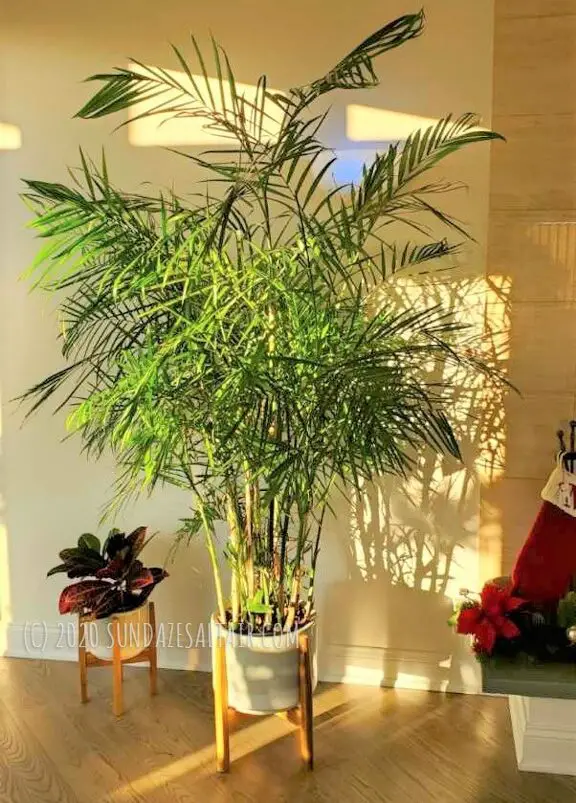
**********
Majesty Palm Mistake #5: Too Much Water
Signs your Majesty palm is getting too much water:
Palm fronds, leaves turn yellow; eventually roots turn brown & soft with prolonged exposure
If you are over-watering your Majesty and subjecting your plant to excessively wet or soggy soil, you are likely to notice the effects in the form of yellowing leaves, and eventually brown and soft, rotting roots if exposure continues.
Solution to excessive water exposure:
Majesty palms love water more than most palms, but if you suspect yours might be overly hydrated be sure to test the dryness of the soil and delay watering if it still feels very wet to the touch. You never want to let your plant get waterlogged.
If excess moisture is the culprit, allow the soil of your Majesty palm to dry out longer between waterings and see if it starts to recover.
Always be sure your Majesty's pot is equipped with a drainage hole to prevent water from accumulating and rotting your palm, as well as preventing a standing water issue. Standing water not only leads to rot but also fungal growth, as well as serving as an open invitation to gnats and other pests.
If you still suspect poor drainage is causing overly wet conditions for your palm, you can also add some stones to your potting mix or soil to ensure any water drains properly and the soil remains aerated.
In addition, if you tend to overwater or if your Majesty gets a lot of shade which keeps your plant wet longer, consider adding some gravel or stones on the surface of the soil. The stones not only look attractive but can also help keep your plant's lower stems and roots away from extended contact with moisture.
***Extra Tips To Care For Your Indoor Majesty Palm: Look For Signs Of A Healthy Majesty Palm
Signs of a healthy Majesty palm include: vibrant green palm fronds and leaves; new buds at the top of your palm's trunk during the spring and summer growing seasons; and your palm's trunk should always feel solid and firm.
Your Majesty Palm's Trunk: Signs To Watch Out For
If you tap your palm's trunk and feel any soft spots or if you hear any hollow sounds then be aware your Majesty palm may be showing signs of rotting or decaying from a fungal infection, a risk in humid conditions. Place your potted palm in a sunnier and drier location and cease all watering until you see signs of improvement.
**********
Majesty Palm Mistake #6: Not Considering The Possibility Of An Insect Or Pest Infestation
Signs Of An Insect Infestation On Your Majesty Palm:
Leaves may yellow and develop a mottled or speckled appearance with brown spots. Also, look for the appearance of a sticky spiderweb-like substance on fronds, leaves and stems.
Even though your Majesty palm is indoors, that does not make it immune from attack by pests like spider mites. Many palms can be magnets for insects and pests such as mites. If you suspect an insect infestation, try the following remedies...
Solution to insect infestations:
Similar to how you would check your child for lice, you may want to periodically check over your potted Majesty palm by looking over its fronds, leaves and stems for any signs of insects, including webbing. If you do spot any bug life making a home on your plant, grab the tweezers and remove as many as possible. Help the process out and ensure you removed all insect squatters by following up with a blast of water from the hose on a warm day outside.
I also like to take a homemade solution of warm mild soapy water and wipe down any leaves and stems. This gets rid of any stragglers as well as any egg sacs thereby preventing future infestations.
Neem oil can also serve as an insect repellent. Just dilute some with water in a spray bottle and spray as needed to eradicate and prevent insect infestations.
If you inspect and clean your Majesty palm's leaves or fronds periodically, you should be able to nip any insect issues in the bud.
**********
Majesty Palm Mistake #7: Not Fertilizing Your Majesty Palm
Symptoms Your Majesty Could Use Some Food, AKA Fertilizer:
General yellowing of your majesty palm's leaves with no other symptoms
Yellowing palm fronds can be a sign that your Majesty palm is deficient in vital nutrients, particularly magnesium which could lead to pale, discolored fronds or leaves and slow growth. According to many horticulturists, palms benefit from the addition of regular fertilizer application. The indoor Majesty palm, in particular, benefits from fertilizer application during the growing season of spring and summer which can provide nutrients your plant is lacking.
Fertilizing your palm periodically can also help keep pests, including spider mites, at bay.
Solution: A gentle fertilizer to feed & care for your indoor Majesty palm
Like most palms, the Majesty palm also has very specific requirements for the type of fertilizer it prefers, which are not typically met by generic fertilizers. Fertilizers that are sold specifically for palm trees meet these requirements because they contain a nutrient essential to palm trees, magnesium, as well as other vital trace elements. While the ideal palm fertilizer for outdoor, inground Majesty palms should consist of 8 percent nitrogen, 2 percent phosphorus, 12 percent potassium, and 4 percent magnesium, indoor potted Majesty palms require a slightly different blend of nutrients. You can identify the type of fertilizer by looking for the numbers printed on the bag.
What Fertilizer Is Best For Potted Majesty Palms? When & How Often Should You Fertilize Your Potted Majesty Palm?
Indoor potted Majesty palms, on the other hand, require a higher level of nitrogen in their fertilizer blend. Therefore, when choosing fertilizer for your potted palm, you want to look for a liquid fertilizer labeled 18-6-12 for best results. Apply a slow-release liquid formula every three months to your potted palms.
Make sure to only fertilize your Majesty palm during the active growing season of spring and summer. Do not fertilize your Majesty during the slow, dormant winter months as it could be potentially harmful to your plant.
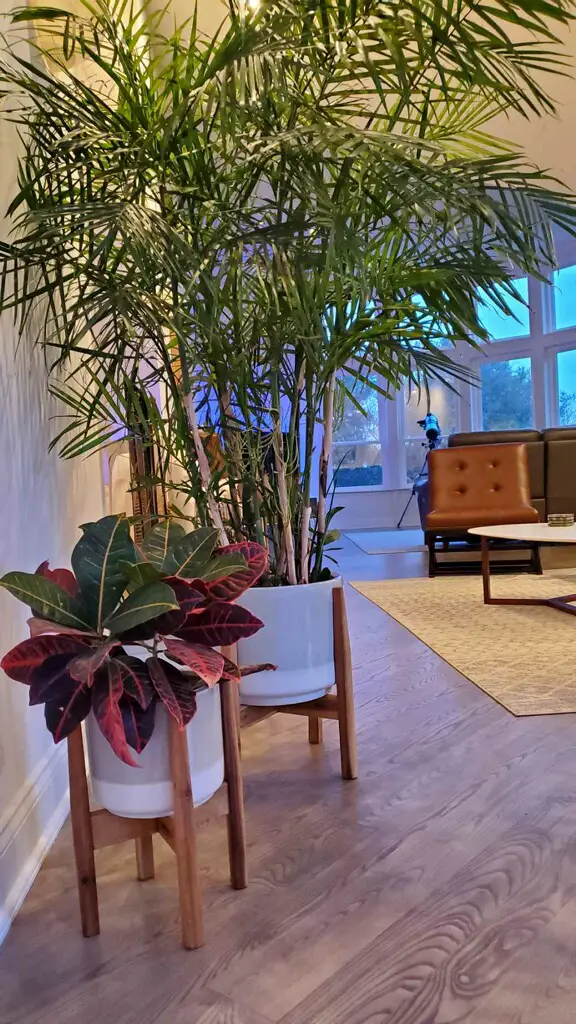
A Few More Tips To Care For Your Indoor Majesty Palm
Repotting Your Majesty Palm: When It Outgrows Its Home
While Majesty palms are slow growers, they will eventually outgrow their home. Like most living things, it needs space to thrive, so avoid overcrowding by periodically repotting your Majesty. This is especially important if you see signs of overcrowding such as any roots starting to pop out of the soil. There is no need to upgrade to a very large pot, just increase the pot size by about two inches with each repotting.
Periodically Prune Your Potted Palm To Keep It Neat & Promote Growth
Keeping your potted Majesty looking its best is easy with frequent pruning. Just pinch off, or cut, any palm fronds or leaves as they turn yellow and brown. They should come off easily, paving the way for fresh new growth while maintaining your palm's sleek and neat appearance.
**********
Enjoy Lush Tropical Scenery Wherever You Live & Avoid Seven Common Mistakes By Following These Easy Tips To Care For Your Indoor Potted Majesty Palm
With its classic good looks and compact size, the Majesty palm adds timeless elegance and coastal chic to both indoor and outdoor spaces. By following these tips on how to care for an indoor potted Majesty palm you will be able to recognize and quickly treat signs of an unhealthy Majesty. Consistent care will ensure your Majesty continues to bring that laidback tropical island feeling to your home for years to come - no matter how far from the tropics you may live.


You May Also Like
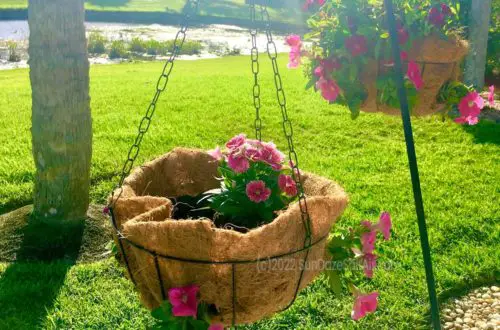
How to Make Beautiful Hanging Flower Baskets Like Disney Using Coconut Coir Liners: 11 Tricks for Amazing Flower Baskets
March 9, 2022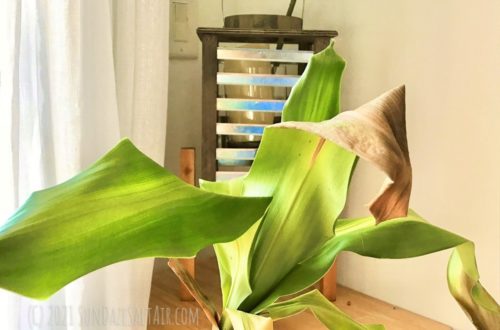
Why Are The Leaf Tips Of My Corn Plant (Dracaena) Brown & Drooping? How To Revive A Drooping Corn Plant
August 13, 2021